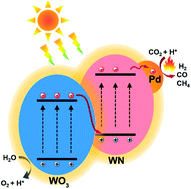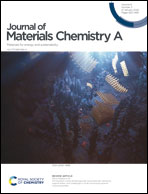Photothermally assisted photocatalytic conversion of CO2–H2O into fuels over a WN–WO3 Z-scheme heterostructure†
Abstract
CO2 conversion into value-added fuels has been considered as a promising solution to solve environmental problems and energy crises. However, the efficiency of photocatalytic CO2 conversion is low. In addition, infrared light in the solar spectrum is not utilized properly in most traditional photocatalytic reactions. Thus, the search for photocatalysts that exploit the wide solar spectrum to achieve an efficient water-based CO2 conversion performance is still highly challenging. Herein, we construct a WN–WO3 Z-scheme heterostructure to exploit the wide solar spectrum for efficient CO2–H2O conversion into fuels (H2, CO, and CH4) without any sacrificial agents. After 5 h irradiation, the yields of H2, CO, and CH4 are 3.0, 1.4, and 1.9 times higher than that of WN, respectively. The activity improvement is ascribed to the direct Z-scheme mechanism of the WN–WO3 heterostructure under ultraviolet-visible illumination. In addition, the infrared light in sunlight is also utilized by the WN–WO3 heterostructure to generate heat via photo-to-thermal conversion, which further accelerates such a conversion reaction. This work offers a unique perspective for designing transition metal nitride/oxide heterostructures and paves a new way to boost the CO2-to-fuel conversion performance.



 Please wait while we load your content...
Please wait while we load your content...